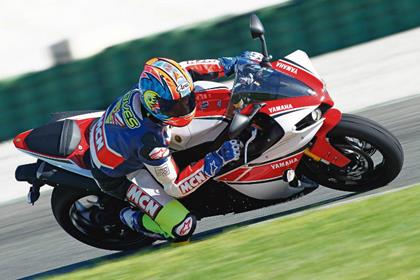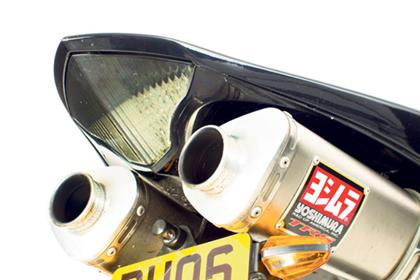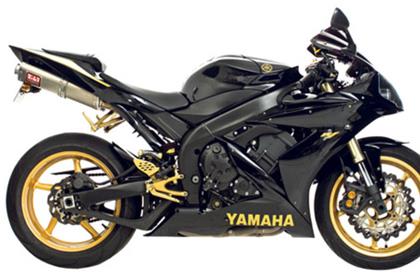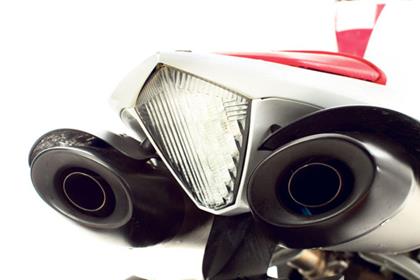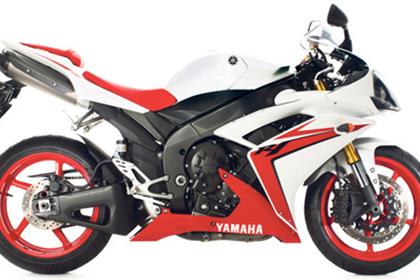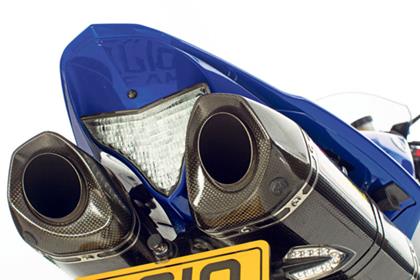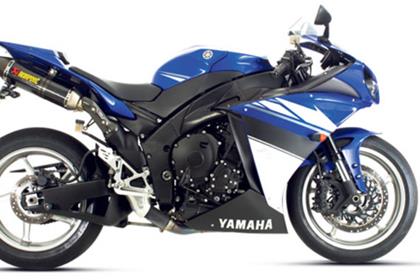Used buying guide: Yamaha R1
If you have to pick out a year that marked the revival of the litre bike category then look no further than 2004.
With World Superbikes turning to 1000cc inline fours rather than 750cc homologation specials, the pressure was on the Japanese in the early-noughties to deliver to riders a whole new breed of affordable sportsbike.
The litre bike war was about to kick off and there would be no prisoners taken…
Having effectively created the big-capacity sportsbike class in 1992 when it launched the FireBlade, Honda was now playing catch-up. Yamaha had moved the game on in 1998 with the ground-breaking YZF-R1 but by the end of 2003 it too was lagging behind the mighty Suzuki GSX-R1000.
Suzuki had caught everyone napping in 2001 and unlike the FireBlade and R1, which were nearing the end of their life cycles, the GSX-R was a bike at the very beginning of its development.
However, at least Honda and Yamaha were in the game, Kawasaki were only noticeable by their absence. Something had to give and in 2004 the whole litre bike class exploded into action.
In a wonderful display of ‘who can piss the highest’ both Kawasaki and Yamaha held back on announcing their power and weight figures until the competition blinked first.
Yamaha went for it and stated their new stunning looking R1 was the first litre bike to have a 1:1 power to weight ratio, claiming 172bhp and 172kg. A few days later Kawasaki claimed the new ZX-10R had 172.6bhp and weighed 170kg…
But at the end of the day who cared? As well as the second generation of GSX-R1000, which now had radial brakes and an improved chassis, riders had the choice of the truly mental ZX-10R, mini-RCV Fireblade or visually stunning underseat pipe R1. The litre bikes had come of age and few lamented the demise of the 750cc class.
Having developed this new style of R1, Yamaha failed to regain the class domination that the original model had enjoyed. The Kawasaki stole the aggression headlines, the Honda was known for its chassis and the GSX-R was still the one to beat, especially when it was updated in 2005 to the sublime K5 model.
Never a company to shy away from a challenge, Yamaha decided to up the R1’s aggression by losing a valve and turning their back on a history of five-valve head sportsbike engines.
Despite regaining the R1’s sharp side, not to mention the iconic red seat, the 2007 ‘four-valve’ R1 still wasn’t quite as good as the competition, especially when Honda updated the Blade in 2008. But Yamaha had something very special in the wings…
Some claim the ‘cross-plane crank’ is simply a marketing tool and isn’t that effective in the real world, however in a world of dizzying horsepower figures the 2009 R1 stood out from the rest of the Japanese inline fours as something different.
A new piece of technology had arrived and as first Valentino Rossi and then Ben Spies dominated on track using a cross-plane engine, the R1 started to develop a following.
Then the financial crisis hit and Europe grew in stature with BMW, Ducati and Aprilia all upping their game as the mighty Japanese manufacturers struggled.
When you look at the development of the ‘underseat pipe’ R1 models you have to be impressed both by Yamaha’s engineering skill and willingness to take a risk.
In 2004 they started with a brand new engine, in 2007 they changed their thinking on decades of engine development and finally in 2009 they launched a truly unique style of inline four motor. That’s some track record.
2004-2006 Yamaha YZF-R1
![]()
Price for a good one: £3,400 to £5,500
Engine: 20v dohc, 998cc liquid-cooled inline four
Power: 172bhp @ 10,500rpm
Torque: 81ftlb @ 10,500rpm
Weight: 172kg
Seat Height: 835mm
Wheelbase: 1395mm
Top speed: 177mph
MPG: 38
What was it like then?
When Yamaha pulled the covers off the first underseat pipe R1 many agreed that the Japanese had finally matched the Italians when it came to styling, especially as the competition from Ducati was the controversial 999.
Claiming 172bhp from a brand new 998cc inline four with the firm’s traditional five-valve head design, the R1 was the first litre bike to hit the magic 1:1 power to weight ratio thanks to a 172kg dry weight. And when you factored in the forced airbox Yamaha claimed the R1 actually produced 180bhp!
Unfortunately for Yamaha the very same year they re-worked the R1, Honda reinvented the Fireblade and Kawasaki launched the ZX-10R. On track the Blade’s amazing chassis made the R1 feel slightly lethargic while if you wanted a truly brutal liter bike then the ZX-10R was the only choice. However against such tough competition the R1 still managed to top the UK’s sales charts thanks to some clever thinking by Yamaha.
While the rest of the Japanese went after younger riders, Yamaha aimed the R1 at older sportsbike fans, something that explains why it came in slightly somber colours.
The R1 was no longer the brash youngster the 1998 model had been, it was now a mature and sensible, yet still blindingly fast, sportsbike that hoped to attract riders with its excellent build quality and sophistication.
![]()
Despite commanding a hefty premium over the Japanese competition, the R1 won the litre bike sales war in 2004 – unfortunately 2005 was a different story.
The return of the GSX-R1000 put a serious dent in the R1’s sales and despite a slight update in 2006 the R1 failed to top the charts again. Did riders want a sportier R1 rather than the refined bike that was currently on sale? Yamaha tested the water in early 2006 with the R1 SP. Yamaha were convinced, the R1 needed a new lease of life and an injection of aggression…
What is it like now?
The first generation of underseat pipe R1 is a very solid performer with excellent reliability and build quality that is now starting to look good value in the second hand market. Prices are hovering around the £3-£4,000 mark for an early model and for this amount of money you are getting a lot of bike.
The inline four engine has a very smooth power delivery that although not blisteringly quick low-down, is still hugely impressive when it gets going.
With a genuine 153bhp at the rear wheel you can’t accuse the R1 of being slow, but some horribly high gearing does tend to make it feel slightly lethargic to accelerate when compared to the lively Kawasaki. That said, when you are up to speed the R1 is rock solid in the bends, something the ZX-10R can never be accused of…
Second hand R1s tend to fall into two camps – dripping in bling or totally stock. Generally it is best to go for a stock bike, however sensible modifications such as suspension upgrades and braided lines are worth spending a few extra quid on.
2007-2008 Yamaha YZF-R1
![]()
Price for a good one: £5,000 to £6,000
Engine: 16v dohc, 998cc liquid-cooled inline four
Power: 177bhp @ 12,500rpm
Torque: 87ft.lb @ 10,000rpm
Weight: 177kg
Seat Height: 835mm
Wheelbase: 1415mm
Top speed: 182mph
MPG: 38
What was it like then?
Yamaha launched the 2007 R1 under the banner ‘excitement intensified’. Having faced criticism that their previous model of underseat pipe R1 felt a bit muted, Yamaha hit back with the updated model by injecting a new found urgency into the R1’s engine that had been lacking before.
This model, they claimed, would stir up memories of the original 1998 R1, a bike that was packed full of character and naughtiness. And just to emphasis the point they even gave the 2007 bike a brash red seat to go with its red and white paint scheme – how very nineties…
While the big headline news with the 2007 R1 was the fact Yamaha had gone against tradition and dropped the five-valve head for a more conventional four-valve design, it was surrounding the engine that the real news could be found. Aside from the head the motor is essentially the same as the previous model, however the 2007 bike was the first R1 to have YCC-T ‘ride-by-wire’, a system that was debuted on the 2006 YZF-R6.
s well as the YCC-T the R1 also gained YCC-I, variable length intake funnels that were claimed to bolster mid-range without hampering top-end performance. Add to this a new shock with high and low speed compression damping, six-piston radial calipers, a revised chassis, slipper clutch and new forks and you had the sportiest R1 to date. Which was the problem…
The 2007 R1 was chalk and cheese compared to the previous model. Lacking in drive until 8,000rpm, the new R1 suddenly introduced a searing power band into the equation, creating a bike with genuine character but also irritations. The YCC-I did little to fill the R1’s gaping hold in the mid-range, but at least the new four-valve head machine was certainly entertaining to ride and the chassis vastly improved.
![]()
The 2007 model removed the slightly lazy steering that had hampered the first generation of underseat pipe R1, replacing it with a sharper edge that helped the Yamaha keep up with the more track focused competition. With the beating of the ZX-10R Fireblade, the R1 was only topped in 2007 by the updated GSX-R1000.
Unfortunately for Yamaha the next year Honda launched the brand new Fireblade, Kawasaki re-designed the ZX-10R and Ducati’s 1098 started to steal sportsbike sales away from the Japanese. Yamaha needed something to set the R1 aside from the other inline fours, it arrived in 2009.
What is it like now?
This model of R1 is a bit of a ‘rider’s bike’, a machine that is often overlooked due to its irritating lack of grunt but owners rave about as they perceive this as character. While it is true to say it is a very entertaining model, it is also pretty annoying when you know you have a genuine 161bhp but need to change down a gear to overtake!
Due to the enthusiastic nature of their owners, second hand 2007/08 models of R1 tend to be used with mileages over 15,000 fairly common.
The engine is bullet proof, so this isn’t an issue, however when buying second hand the increased wear means the condition of items such as bearings and suspension seals need to be investigated.
The 2007/08 R1 is a bike stacked with character that has an excellent chassis, thrilling motor and degree of rarity about it. Very few riders remember the first four-valve R1 and the red/white paint scheme is as cool today as it was back in 2007, or 1998 for that matter!
2009-2011 Yamaha YZF-R1
![]()
Price for a good one: £6,500 to £9,000
Engine: 16v dohc, 998cc liquid-cooled inline four
Power: 179bhp @ 12,500rpm
Torque: 85ft.lb @ 10,000rpm
Weight: 206kg
Seat Height: 835mm
Wheelbase: 1415mm
Top speed: 182mph
MPG: 40
What was it like then?
When Yamaha announced the arrival of the 2009 YZF-R1 all the talk centered around the new ‘cross-plane crank’ engine.
Developed on Yamaha’s MotoGP winning M1 race bike, the cross-plane crank was claimed to help reduce something called inertial torque. Where a conventional inline four’s pistons move in pairs, the cross-plane’s pistons are spaced unevenly, creating a unique ‘long band’ firing order.
Sometimes confused with a ‘big bang’ engine, which it is not, the cross-plane design ensured that the R1’s pistons weren’t all stationary at the same point like they are on a conventional inline four, smoothing the power delivery and helping drive out of corners. Well that was the theory, what riders noticed was the fact this was a Japanese inline four like no other.
The engine didn’t sound or respond like a conventional inline four, instead it was lumpy and grumbly like an off-beat V-twin at low revs before clearing its throat at 6,000rpm and driving like no R1 before it.
A weird combination of twin and inline, the R1 left riders confused but intrigued by its revolutionary technology. However this wasn’t the main problem the R1 faced.
When Yamaha initially unveiled the R1 the price was thought to be around the £9,999 mark, a figure which increased to £10,999 by the time it was in the UK and put it over £1,000 more than the competition. While it came stacked with new technology, not to mention the fact Ben Spies was dominating WSB, the other litre bikes were hardly slouches and the exotic Ducati 1198 wasn’t that much more money.
![]()
For a year the R1 had enough hype surrounding it to push sales and Yamaha couldn’t bring enough into the UK, especially in the classy blue colour, but then BMW unveiled the S1000RR…
The BMW arrived with a competitive price tag, staggering electronics package and simply wiped the floor with the Japanese inline fours. The R1’s hype evaporated away and with a price tag now pushing £12,000 (although dealers were still selling them for just over £10,500) the R1’s sales dropped.
What is it like now?
Although certainly not the best performing litre bike, the R1 still stands out as something different to the conventional competition. The cross-plane engine is unique in both its sound and performance and although down on power when compared to the likes of the S1000RR or ZX-10R, the R1 is an easy bike to ride on the road and track as long as you aren’t looking to push it too hard.
Back to back with the BMW or Kawasaki the R1 feels a bit heavy and less agile, however what it lacks in outright performance it more than makes up for in character. With a set of race pipes the R1 sounds simply fantastic thanks to its off-beat exhaust note while the level of build quality is absolutely top draw.
Prices for a second hand cross-plane R1 start at £6,500, which is nearly half the cost of a new model and you are only really lacking traction control. Looking at it in this light the R1 is a solid second hand buy for those wanting a classy Japanese inline four that is anything but run of the mill.
